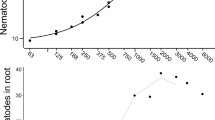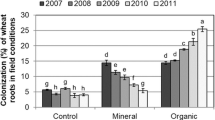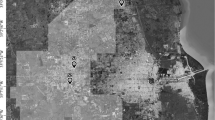Abstract
Populations of plant parasitic nematodes and their effects on symbiotic nitrogen (N) fixation in herbaceous legumes and on some selected characteristics of other plant species associated with such cover crops were studied. Two legume species [mucuna, Mucuna pruriens (L) DC. var. utilis (Wright) Bruck and lablab, Lablab purpureus L. Sweet], one grass/weed species [imperata, Imperata cylindrica (L.) Rauschel] and a cereal (maize, Zea mays L.) were used. There were three soil treatments (fumigation, fumigation plus inoculation with Meloidogyne species, and an untreated control). Plant parasitic nematode populations in soil, roots and nodules were determined at 4, 8 and 12 weeks after planting. The response of the phytoparasitic nematodes to soil treatments varied according to the plant species present. The predominant nematodes in soils, roots and nodules of legumes were of the genus Meloidogyne, whereas other genera of parasitic nematodes dominated the fauna in soils and roots of maize and imperata. Biomass yield of mucuna was not significantly affected by either Meloidogyne spp. or the other genera of phytoparasitic nematodes. In contrast, the dry matter yield of lablab measured at 12 weeks was reduced by 16% in inoculated compared with fumigated soils. Similarly, the biomass yields of maize and imperata were reduced by 10% and 29%, respectively, in unfumigated rather than fumigated soils. The amounts of N accumulated in mucuna, maize and imperata were not significantly affected by the two groups of plant parasitic nematodes. However, at 12 weeks, lablab grown on inoculated soils accumulated only 69% of the N found in plants grown on fumigated soils. Inoculation of soil with Meloidogyne spp. significantly increased the number of nodules on lablab roots compared with the non-inoculated treatments, whereas nodulation in mucuna was not affected by soil treatment. After 12 weeks, the quantity of N2 derived from symbiotic fixation in mucuna was not significantly affected by soil treatments whereas the amount of fixed N in lablab was 32% lower in inoculated than in fumigated soils. Possible mechanisms for the non-suppressive effect of plant parasitic nematodes on mucuna are discussed.
Similar content being viewed by others
Author information
Authors and Affiliations
Additional information
Received: 12 March 1999
Rights and permissions
About this article
Cite this article
Ibewiro, B., Sanginga, N., Vanlauwe, B. et al. Influence of phytoparasitic nematodes on symbiotic N2 fixation in tropical herbaceous legume cover crops. Biol Fertil Soils 31, 254–260 (2000). https://doi.org/10.1007/s003740050654
Issue Date:
DOI: https://doi.org/10.1007/s003740050654




